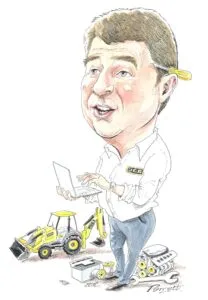As OEMs strive for net zero they should not lose sight of customer requirements, or progress could stall, says Tim Burnhope, group director, special projects at JCB
Readers of this column will recall that in the early part of this year we were getting to grips with the government’s call for evidence into the decarbonation of non-road mobile machines (NRMM). In short, how best to achieve net zero for the kind of machines JCB and its competitors sell in the UK,
Not surprisingly, JCB has nailed its colours firmly to the hydrogen combustion mast. JCB’s £100 million investment in exploring this technology is now in its third year and heading towards being proper solution for zero emissions.
“Ultimately, the best solution is the one where the customer can keep using their machines exactly how they want to”
 Grappling with net zero
Grappling with net zero
While our submission to the Call for Evidence has long since been mailed, we are still reflecting on the process, one which we found immensely helpful in galvanising thinking around which solutions are best for our industry.
Make no mistake, the products that sit under that cumbersome acronym NRMM are diverse. In grappling with the definition of net-zero policies, governments around must decide what’s right for anything from a chainsaw to excavators weighing hundreds of tonnes – and everything in between.
As an industry, we love to debate the technologies which will get us to net zero, but completing the Call for Evidence has given us time out to really understand our products, and more importantly what customers do with them, and demand from them.
A wide range of variables
Using JCB’s LiveLink Telematics system, we are able to see exactly what our customers do with machines every day. Our greatest learning was about the energy (fuel) consumed, the number of hours worked per day, and the location (or locations) where the machine has worked. What is incredible is the sheer variety across every product group, and therefore the wide range of variables we must put into our equation to work out the best technological solution for our customers.
For example, where a tower crane is static and grid electricity is available, tethering may be a sensible option. A mini excavator could also be considered a contender for the tethered electric solution, but when you dive into the detail, the opposite is true. While a mini excavator may only move metres each day on its tracks, it actually moves on average 30 miles a day. That movement is behind a trailer, going from site to site, where a tethered electric solution may not always be an option. It’s these insights which we must take into account when determining what products to create for our customers. Ultimately, the best solution is the one where the customer can keep using their machines exactly how they want to, whenever and wherever they need to.
Automotive comparison
Take the automotive sector, for example. The first adopters of electric cars were accommodating of the changes to behaviour required, and the increased cost because they could proudly claim to be the pioneers of new electric technology. However, as the technology tries to move into the mass market, the challenge of cost, and inconvenience of not being able to use the vehicle as and when you want to, suddenly came into sharp focus, resulting in loss of momentum in the sale of electric vehicles.
So, when we think of the technologies to get us to net zero, we must not think of it in terms of ‘what price increase and inconvenience will our customers cope with?’, but instead ‘how can we continue to design and produce great products that allow our customers to thrive whilst meeting net zero?’. If we are going to net zero, we need to do a proper job.
This article also appears in the June/July 2024 edition of iVT International




